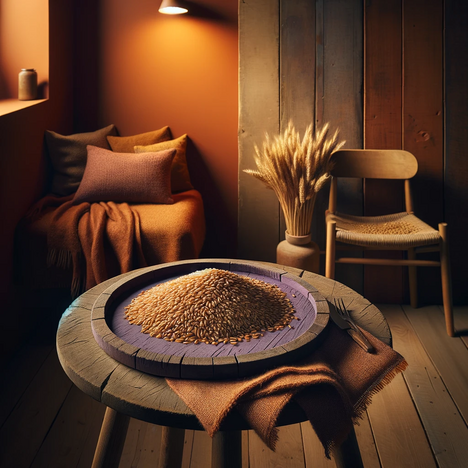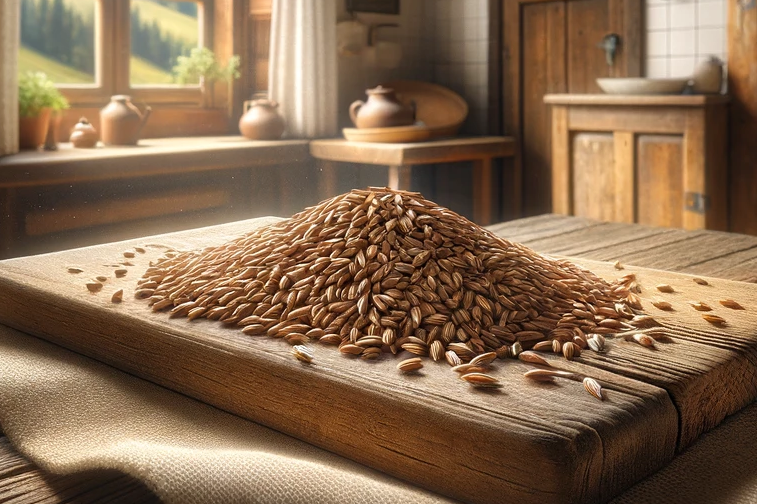Farro

What is farro?
Farro is a collective term for three different types of wheat: einkorn, emmer and spelt. They all originate from Mesopotamia and have been cultivated for thousands of years. Farro is often referred to as the original grain because it has been less modified than modern wheat. Farro has a nutty flavor and a chewy texture. It is usually sold dry and must be cooked in water before consumption.
What are the benefits of farro for dogs?
Farro can have some health benefits for dogs, especially when used as an alternative to refined grains like white rice. Here are some of them:
- Farro is high in protein, which is important for muscle building, wound healing and the immune system. A quarter cup (47 grams) of farro contains about 6 grams of protein, which is more than most other grains.
- Farro is rich in fiber, which can aid digestion, regulate blood sugar levels and increase satiety. A quarter cup (47 grams) of Farro contains about 5 grams of fiber, which is more than 20% of the recommended daily allowance for a dog.
- Farro is rich in magnesium, zinc and vitamin B3, all of which have important functions in the body. Magnesium supports nerve and muscle function, zinc strengthens the immune system and skin health and vitamin B3 helps with energy production and metabolism.
- Farro has a low glycemic index, which means that it does not raise blood sugar levels as much as other carbohydrates. This can reduce the risk of diabetes and obesity in dogs.
What are the disadvantages of Farro for dogs?
Although Farro is healthy, it is not suitable for every dog. There are some potential disadvantages or risks that you should be aware of:
- Farro contains gluten, a protein found in many grains. Some dogs may have a gluten intolerance or allergy, which can lead to digestive discomfort, skin problems or other symptoms. If your dog is sensitive to gluten or has a known allergy, you should not give him Farro.
- Farro contains phytic acid, a substance that can inhibit the absorption of minerals such as iron, zinc and calcium. This can lead to a deficiency of these nutrients if the dog eats too much Farro or doesn't get enough from other sources. To avoid this, you should soak or sprout the farro before cooking to reduce the phytic acid.
- Farro contains more calories than other grains like rice or quinoa. A quarter cup (47 grams) of farro contains about 170 calories, while the same amount of rice or quinoa contains only about 100 calories. This can lead to weight gain if the dog eats too much farro or its total calorie intake is not adjusted. To avoid this, you should limit the portions of Farro and combine it with other low-calorie foods such as vegetables or lean meat.
How to feed Farro to dogs?
If you want to feed your dog Farro, there are a few things you should keep in mind to make it safe and healthy:
- Choose organic whole grain farro that contains no additives or pesticides. You can find it in health food stores, organic food stores or online.
- Soak the farro in water for at least 8 hours or overnight before cooking. This softens it, reduces the phytic acid and shortens the cooking time.
- Cook the farro in fresh water until it is soft and firm to the bite. This takes between 20 and 40 minutes, depending on the variety. You can also add a little salt or stock to improve the flavor.
- Leave the farro to cool before giving it to your dog. You can also store it in the fridge or freeze it to use later.
- Feed your dog only a small amount of farro as a garnish or supplement to their normal food. The exact amount will depend on your dog's size, age and activity level, but a general rule of thumb is that grains should make up no more than 10% of their daily calories.
- Monitor your dog for possible signs of intolerance or allergy to farro, such as diarrhea, vomiting, itching or skin rash. If you notice such symptoms, you should stop the Farro immediately.
Farro is an ancient wheat grain that can have many health benefits for dogs. It is rich in protein, fiber and important nutrients such as magnesium, zinc and vitamin B3. It also has a low glycemic index, which keeps blood sugar levels stable. However, Farro is not suitable for every dog. It contains gluten, phytic acid and more calories than other cereals, which can cause problems if the dog is sensitive or allergic to it or eats too much of it. If you want to feed your dog farro, you should soak or sprout it beforehand, boil it in water, let it cool and only give it a small amount as a side dish.
If you notice any signs of hypersensitivity or poisoning in your dog, you should see your vet immediately. We are not a substitute for a vet, but we try to be as accurate as possible. Every dog reacts differently and we recommend you get a second opinion or consult your vet if in doubt.
Stay healthy and take good care of your four-legged friend!😊
Similar to Farro
Quinoa is a plant from the foxtail family that grows in the Andes. The seeds of the plant are known as quinoa and are similar in shape and consistency to rice or couscous. Quinoa is gluten-free and...
Bulgur is a cereal product made from durum wheat semolina. To make bulgur, the semolina is soaked, cooked with steam, dried again and the husks removed. The remaining grains are then coarsely or...
Amaranth is not a real grain, but belongs to the so-called pseudocereals, such as quinoa or buckwheat. This means that it does not contain gluten, which is often responsible for intolerances....
Green spelt is basically spelt that is harvested in an unripe state and then gently dried. This process gives green spelt a unique flavor and makes it a nutrient-rich ingredient in both human and...



